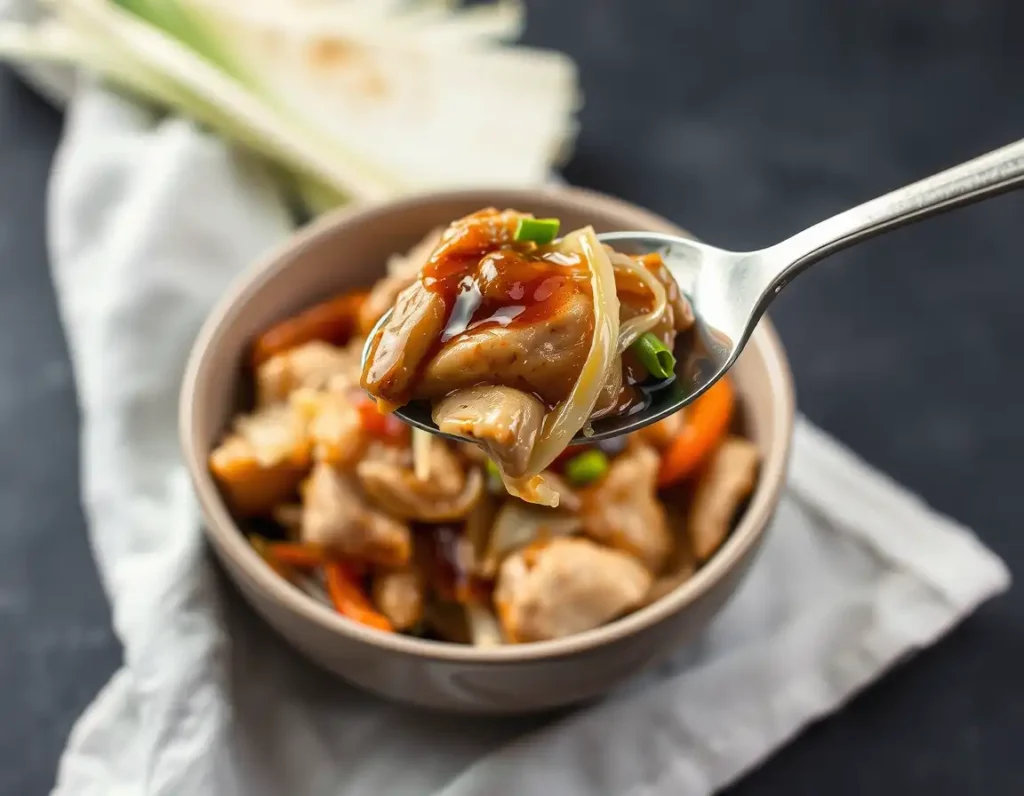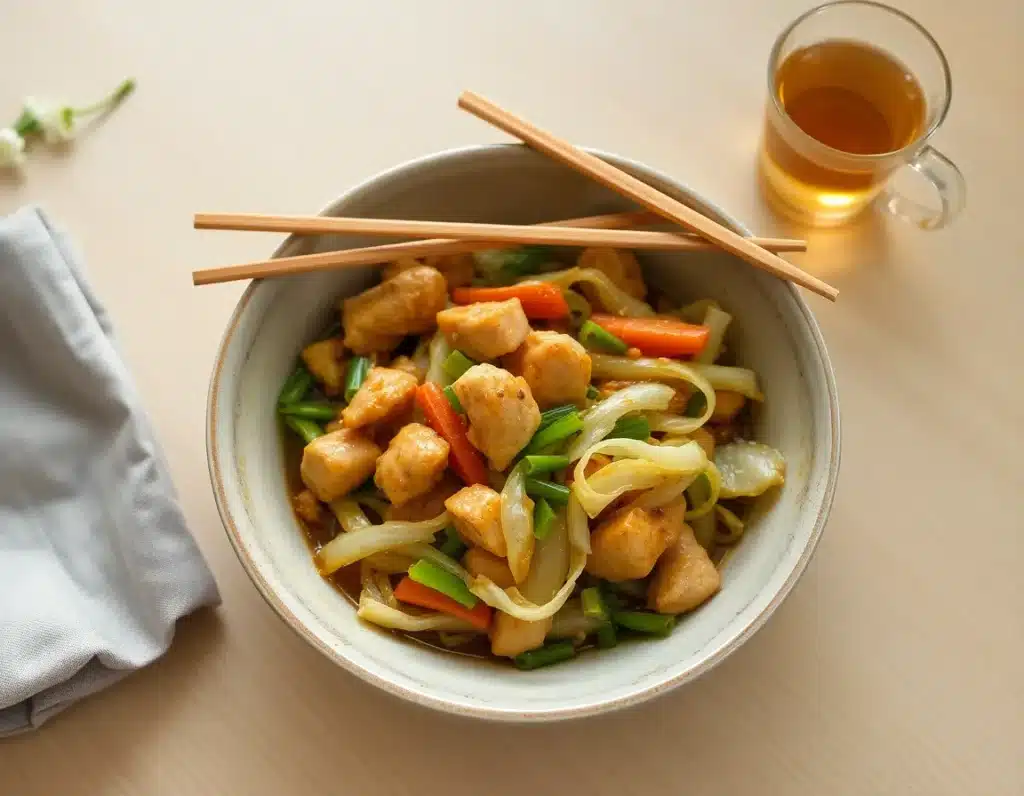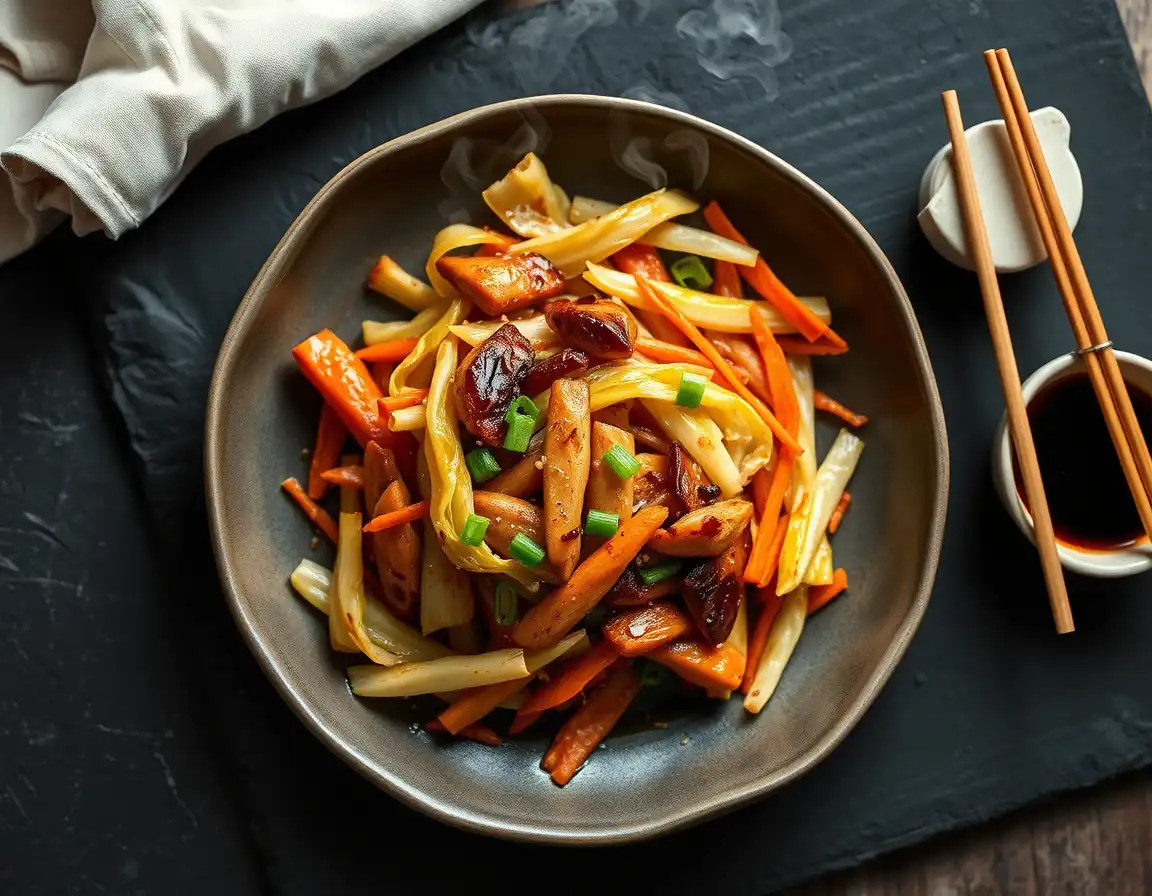One night in Chengdu, I remember sitting on a cracked plastic stool outside a family-run hole-in-the-wall spot. The uncle behind the wok was moving so fast I thought he’d catch fire. That’s when I first tasted real Chinese chicken cabbage stir-fry. It was smoky, crisp, salty-sweet, the cabbage still crunching between my teeth. I went back three times in one week. Couldn’t get it outta my head.
This isn’t your average takeout stir-fry. Chinese Chicken Cabbage Stir-Fry is a deceptively simple dish that leans heavy on technique. It’s lightning fast, honest, and deeply tied to home kitchens across China. You’ll find it in Beijing, you’ll find it in Hunan, and everyone’s grandma has their own way of making it. Mine uses dark soy. Yours might throw in a Sichuan twist. Either way, this dish earns its place by being utterly satisfying, wildly adaptable, and seriously underrated outside China.
There’s a magic in the balance—tender chicken, cabbage that still bites back, that glossy sauce clinging to every piece. And it’s all done in under 20 minutes. Let’s dig in.
Ingredients & Substitutions
Chicken thighs (boneless, skinless) – 500g
Thighs win here. They’re juicier than breast, they don’t dry out as fast, and they carry flavor like champs. But hey, if you’ve only got breast, slice it thin and cook fast. You could also use firm tofu for a veg version—just press it real good so it doesn’t go soggy.
Green cabbage – half a medium head, sliced into 1-inch shreds
Don’t overthink it. Regular ol’ cabbage does the trick. Napa cabbage is also fab, but it softens quicker. Savoy’s nice too if you want something sweeter. Skip the red cabbage—too earthy and it bleeds weird colors.
Garlic – 4 cloves, smashed and chopped
Fresh garlic only. Powder’s a no-go here. You want that pungent hit that hits your nose before your tastebuds.
Ginger – 1 thumb-sized piece, julienned
Don’t skip this. It brings heat and perfume that balances the oil.
Soy sauce – 2 tablespoons (light)
Go for a naturally brewed soy sauce if you can. If you’re gluten-free, tamari works just fine.
Dark soy sauce – 1 tablespoon
This one’s for color and depth. It makes the chicken look glossy and rich. Leave it out if you can’t find it, but the stir-fry might look a bit pale.
Oyster sauce – 1 tablespoon
This stuff is umami in a bottle. Vegetarian? Use mushroom stir-fry sauce instead.
Shaoxing wine – 1 tablespoon
It adds complexity and removes any “chickeny” smell. If you’re dry, dry sherry or mirin (skip the sugar then) are solid backups.
Cornstarch – 1 teaspoon, mixed with 2 tsp water
Thickens the sauce just enough. Don’t dump it in dry or you’ll get clumps like flour in gravy.
Sesame oil – ½ teaspoon
Finish with it, don’t cook in it. It burns and tastes bitter if it hits hot oil.
Neutral oil (canola, peanut, sunflower) – 2 tablespoons
You want smoke point, not flavor. Olive oil’s a no here.
White pepper – ¼ teaspoon (optional)
It adds a subtle sharpness that black pepper just doesn’t bring.
Salt and sugar – to taste
A pinch of sugar makes the cabbage sing. Salt is up to your soy levels—taste as you go.

Step-by-Step Instructions
Chinese Chicken Cabbage Stir-Fry starts fast—prep before heat.
This ain’t a stew. You blink, it’s done. Slice your chicken thin across the grain—think ¼-inch slices. This helps it cook fast and stay tender. Toss it with ½ tbsp light soy, ½ tsp cornstarch, and a drizzle of oil. Let it sit for 10 minutes while you prep the rest.
Heat your wok or skillet till it smokes.
Then add oil and swirl fast. You’re looking for that first sizzle. Drop the chicken in, but don’t touch it for 30 seconds. This builds a sear. Then stir-fry fast till just cooked—maybe 2 minutes. Take it out. Set it aside.
In the same pan, add a bit more oil. Toss in the garlic and ginger.
They’ll go golden quick. Don’t walk away—they burn faster than toast on broil. The smell should punch you in the face a bit. That’s when it’s time for cabbage.
Toss in the cabbage, big handfuls at a time.
Don’t crowd the pan or it’ll steam instead of fry. Stir-fry for 2-3 minutes. You want it softened but still bright and crunchy. Like sautéed lettuce with a backbone.
Add back the chicken, then your sauce mix:
1 tbsp light soy, 1 tbsp oyster sauce, 1 tbsp Shaoxing wine, splash of water, dark soy for color. Toss fast and hard. If it looks dry, add a tbsp more water.
Drizzle in the cornstarch slurry.
One circle around the pan. Stir. The sauce should get glossy and cling like a light coat of lacquer. If it’s gloopy? You used too much. Add water to fix it.
Finish with sesame oil and a whisper of white pepper.
Off the heat. One last toss. Done.
Cooking Techniques & Science
Chinese Chicken Cabbage Stir-Fry lives and dies by heat.
You want high heat, short time. That’s how you get that faint wok hei—smokiness that comes from oil, heat, and motion. If your pan’s not hot enough? You’ll get soggy mess. Ain’t nobody want boiled cabbage.
Why cornstarch in the chicken?
It’s called “velveting.” It wraps the meat, keeping juices in. Also gives a slippery-smooth finish that Chinese restaurant stir-fries have. It’s a tiny step but makes a huge diff.
Timing matters.
Garlic burns in 15 seconds. Chicken overcooks in 2 minutes. Stir-fry like you’re dancing, not painting a fence. Move fast, stay light on your feet.
Use a wok if you have one.
Its shape matters. It lets food toss and catch heat evenly. Flat pans work, but they’re clunky. Carbon steel’s best—nonstick woks just don’t get hot enough.
Don’t add all the cabbage at once.
It drops the pan temperature like ice in a hot bath. Add in stages. This keeps the fry alive.
Serving & Pairing Suggestions
Chinese Chicken Cabbage Stir-Fry belongs on hot jasmine rice. No debate. The kind that’s a little sticky and steamy. It soaks up the sauce, makes every bite rounder.
Want more texture? Add a fried egg on top. Crispy edges, runny yolk—game changer.
Pair it with a cold cucumber salad—rice vinegar, garlic, sesame oil, maybe a bit of chili crisp if you’re brave. The crunch plays nice against the softness of the stir-fry.
Cold Tsingtao or oolong tea is the way to drink. Don’t reach for red wine—feels weird with soy sauce.
Plating? Family-style is king. One big bowl in the middle. Chopsticks or spoons, doesn’t matter. Let people fight over the last piece of chicken—that’s when you know it’s good.

Conclusion
Chinese Chicken Cabbage Stir-Fry isn’t flashy. It doesn’t need to be. It’s fast, flexible, and packed with flavor. You can change the veg, swap the protein, turn the heat up or down—it still holds strong.
The magic’s in the method. Hot pan, sharp prep, fast hands. That’s how you make something humble taste like home.
Wanna impress someone with “just cabbage and chicken”? This is how. But remember—don’t crowd the pan. Don’t skip the ginger. And don’t ever walk away from garlic in hot oil.
Now go stir-fry like you mean it.
FAQs
Can I make Chinese Chicken Cabbage Stir-Fry ahead of time?
Sorta. You can prep everything—slice the meat, chop the cabbage, mix the sauce. But don’t cook it till right before eating. It loses crunch fast. Leftovers are fine, but fresh is king.
What’s the best cabbage to use?
Regular green cabbage is your workhorse. It holds its shape, has bite, and doesn’t go mushy. Napa is sweeter and softer—use it if you want a gentler dish.
Is there a vegetarian version?
Yup. Swap chicken for tofu or mushrooms. Shiitakes are awesome here. Just make sure to press tofu well and maybe fry it first to get some texture.
Why does my stir-fry come out watery?
Either your pan wasn’t hot enough or you overcrowded it. High heat and room to breathe—that’s how you fry, not steam.
Can I freeze this dish?
Nope. Cabbage turns into sad mush when frozen and thawed. Make it fresh. Eat it hot. Repeat as necessary.

Olivia P. is a seasoned food blogger at Tastywink, sharing delicious, easy-to-follow recipes inspired by him passion for home cooking. With years of culinary blogging experience, he brings flavor, creativity, and a personal touch to every dish.
